P2 Case Study - J.M. McKenney Middle School
By Joe McDonoughThe Positivity Project has the potential to shape the culture of an entire middle school in a way that brings people together, provides identity, and acts as the foundation for many other school efforts. When implemented purposefully and consistently — with an eye toward creating intentional experiences designed to define what your school stands for — P2 opens the door to the place students and staff want to be.
Learning About The Positivity Project
I first heard about The Positivity Project (P2) in the spring of 2017. A teacher in a neighboring district had begun to implement P2 in his classroom, and word was spreading. At the time, I was the elementary principal in my district. One of the teachers in my school had a child in the classroom piloting P2. It did not take a lot of convincing to pique my interest.
That same spring, I attended a P2 100 training in Syracuse, NY with a team of three teachers from the elementary school. We left with a plan in place to inform our entire school about P2 and build interest for schoolwide implementation the next school year. In the fall of 2017, we implemented P2 schoolwide in the elementary school and had great success. In fact, P2 in that building is still going strong under the leadership of a different principal.
In the 2018-19 school year, I moved to the middle school as principal and brought P2 with me. The initial implementation began with a summer planning conference comprised of interested middle school teachers who would turn into our P2 committee.
Now entering my 5th year at J.M. McKenney Middle School, I cannot imagine our school without The Positivity Project. We have found P2 to be a perfect fit for middle school students’ developmental and social-emotional needs. But the impacts of P2 have reached beyond students. P2 has also shaped the experiences of the adults in our building – and played a critical role in developing our identity and culture as a school.
At this point, if I were to start a school year by announcing that we would no longer be doing P2, I think there would be a revolt; it has become such a fundamental part of what we do and who we have become.
How do we implement P2 in middle school?
Daily Lessons
Our middle school is a team-based school (our school is grades 5-8). Each grade level has its own team of teachers who collaborate extensively on all aspects of our instructional program, including P2.
Teams in grades 6-8 share the responsibility for leading daily P2 lessons. Generally, one team member will be responsible for a week of P2 instruction. Teams assign these responsibilities on their own following the character strength calendar. There are several benefits to this model:
- First, the loss of instructional time for departmentalized teachers is spread across the entire team. Even with a wholehearted desire to have P2 in our school, time is limited and precious. So having to only take time out of instructional plans one week out of every 4-5 weeks is helpful.
- Second, having P2 sessions led by more than one teacher (while maintaining consistent daily instruction) throughout a grade level team is impactful for students. Each teacher brings something different to their approach to P2, enhancing the lesson delivery and discussions. Seeing the whole grade level team participate in our P2 implementation helps students recognize that this is simply part of our school – and something we all believe is important.
5th grade is the only grade level not departmentalized. Therefore, it has an implementation model that is unique in the building. In 5th grade, there is time built into the daily schedule of each homeroom to conduct P2 lessons. These lessons are primarily led by the students’ homeroom teacher, though there are some occasions where other teachers may take the lead on a particular topic or character strength.
Schoolwide Events
P2 Kickoff Assembly
Starting in the fall of 2018, my first year in the middle school, we held a P2 kick-off event on the first day of classes. This assembly was critical for our initial implementation’s success, but has proven equally important in subsequent years to keep our momentum going – and to welcome incoming 5th grade students into our school culture.
The kick-off consists of an assembly to reacquaint students with P2 and share the vision of our school’s focus for the year. For example, one year, I stressed the importance of the Other People Mindset and used that as a touchstone for other events throughout the year. We also use the kick-off assembly to introduce all of our faculty and staff to students by bringing them to the front of the auditorium and having them tell students their top character strength. This may not have to happen every year, but we deemed it an essential element of our initial kick-off.

The morning of the kick-off is also an opportune time to have students take the VIA Character Strengths Survey. We believe that students’ self-awareness of their strengths proves invaluable for teachers during weekly discussions.
We end the kick-off event every year by gathering the entire school outside and taking an aerial photo of everyone making some sort of P2 or school-related design (see photos below for examples). The simple act of having every human being in the school focused on the same task on the first day of classes brings people together. I often include these photos in my assemblies because they serve as quick touchstones of the importance of being a team.
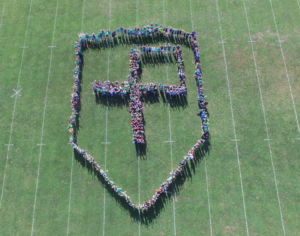
Fall 2018
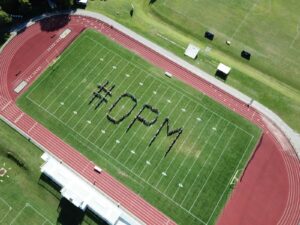
Fall 2019
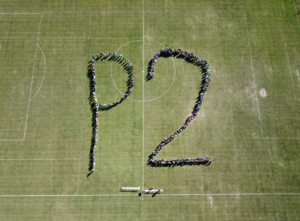
Spring 2021 (taken two different days due to hybrid model and then edited together)
P2 Assemblies
In typical years, we hold five P2 assemblies per year, with the entire student body present at the same event. For obvious reasons, some of this changed with covid, but we either had virtual assemblies or several small assemblies to keep our momentum going. The five assemblies consist of the kick-off event followed by four quarterly events. Each assembly consists of a presentation and the recognition of students who have modeled the character strengths and Other People Mindset elements covered during the time between events.
I look at the presentation component of the assembly as a whole school P2 lesson with me as the facilitator. These presentations allow us to set the tone for P2 in our school and help tie together the larger themes we see emerging from the weekly lessons. We have talked about kindness, perseverance, the power of “yet”, becoming your best self, and other topics.
I believe it is essential for the entire school to see the principal embodying P2. It is not just something teachers do 15 minutes per day; it can become a vehicle for positive change in the school’s culture.
Student Recognition
At the end of each assembly, we discuss “the strengths in others.” During this assembly component, we recognize students who have acted as exemplars of particular character strengths or Other People Mindset elements. I always remind the student body that we all possess each of these strengths and that we can learn from each other in helping us become our best selves. Students are called up and receive a framed certificate as an award. We have observed that recognizing students for their character strengths allows us to positively acknowledge a broader range of students than can sometimes be done with other measures. Students are genuinely proud of the recognition, and other students cheer their success.
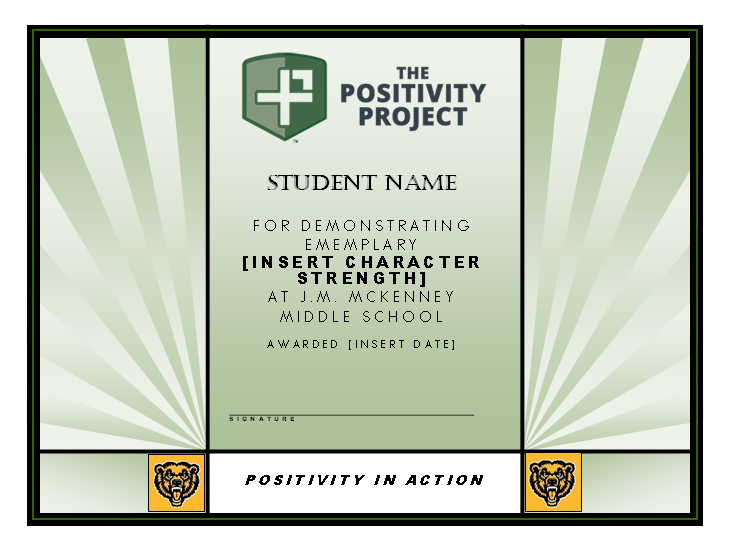
A quick anecdote: After one assembly, I noticed a student was particularly pleased with being recognized. He approached me and said, “You know, I was just saying on the bus this morning how I have never gotten one of these awards. I was upset. Now look!” He was beaming and so proud of himself. When we took his picture (which we then send home to families), he said, “I don’t even need to fake a smile for this!”
Bulletin Boards
We have one large wall in the central atrium of the middle school that we like to use for a rotating schoolwide bulletin board. This is always at least tangentially P2 related and often connects to a P2 assembly. Typically we have students involved in creating the bulletin board so that it becomes yet another reminder of our connectedness as a team.
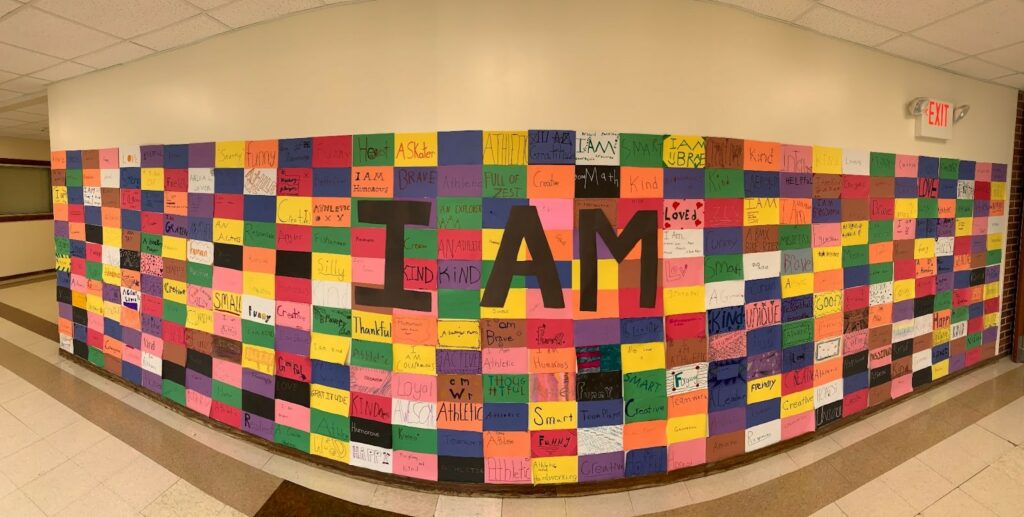
The “I Am” Wall–students wrote one word to describe themselves. Each individual then becomes part of the larger whole that is our school.
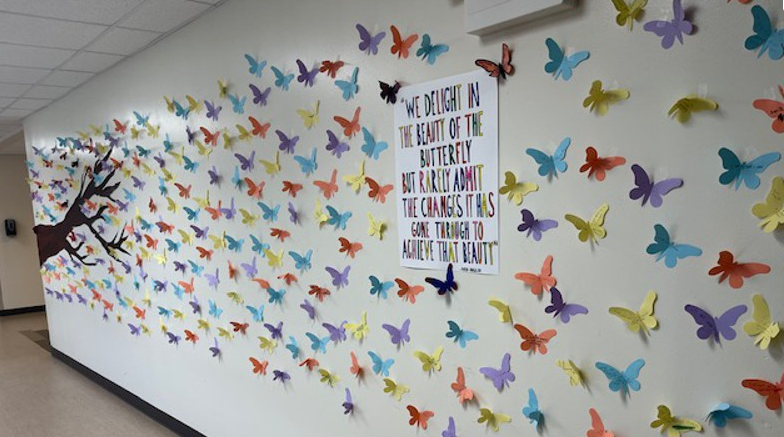
Like caterpillars changing into butterflies, students each wrote one item they wanted to focus on to move toward becoming their best selves.

Be the Light came from a P2 Kickoff assembly. Students each drew a lighthouse prior to the assembly, and we then used them in the presentation to show how we are each unique and have the ability to become our best self.
Gratitude Notes
Every fall, our school – including both students and adults – focuses on gratitude. One of the best ways we have found to learn about and experience the benefits of cultivating gratitude is to express gratitude to one another through simple, written notes. This note-writing has been a popular activity every year and has even spread to the elementary and high schools. You can find more information about these gratitude notes on The Positivity Project blog.
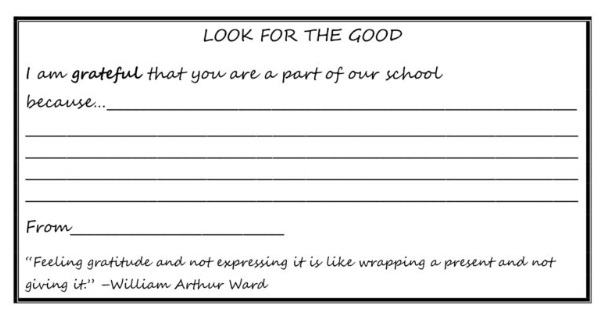
Communication – Clear and Consistent
P2 is consistent for students through daily lessons and bulletin boards. However, consistent communication – and exposure to P2 information – is critical for both staff and families as well.
Weekly Staff Notes
I send weekly staff notes, essentially just an email every Friday afternoon with pertinent information about the upcoming week. Although this email could be a very transactional document and still be effective at accomplishing its task, I consistently start my weekly staff notes with P2 information and an inspirational quote connected to the upcoming P2 topic. The example below demonstrates that this does not have to be elaborate. Consistency is the key.*
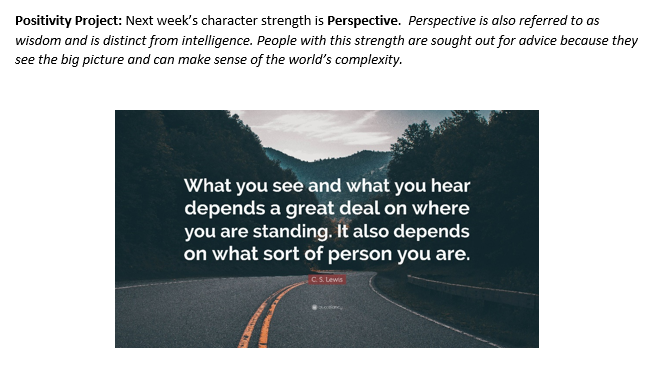
Bi-Weekly Family Newsletter
Our school also electronically sends out a biweekly newsletter to families to keep people informed about current happenings in the school. We are always mindful to include P2 information, including upcoming character strengths, resources for P2 for Families, and pictures from any P2-related activities.*
*Note: You can pull written content for these emails directly from P2’s character cards or family information letters.
P2 for Educators
One of the key insights I have gained from implementing The Positivity Project at the middle school level is that P2 equally impacts the adults and the students in the building. Of course, the impact on adults naturally occurs through interactions with students found in daily P2 lessons and during schoolwide events. Yet, I have found that incorporating P2-related themes into professional development and faculty meetings is powerful. That’s because it helps provide fuel to sustain motivation and time to reflect on topics that sit below the surface of much of the work we do in schools.
P2 for Educators is a tool I use to speak directly to my staff about P2 themes. It consists of a series of ready-made presentations and facilitator notes designed to purposefully bring the benefits of The Positivity Project to school professionals. The purpose of P2 for Educators is to enhance school culture and individual well-being by deliberately engaging staff members, as adults, on the importance of positive relationships and character strengths in their own lives. These P2 for Educators sessions create a time and place for educators to learn, discuss, and plan future actions based on current research connected to education, positive psychology, and the cultivation of individual and collective well-being.
I have used P2 for Educators in two different ways:
- as a district-wide professional development offering that teachers can register for, and
- as components of faculty meetings for the middle school
The professional development offering is a series of ten separate after-school sessions for teachers interested in participating in P2 for Educators. In our district, teachers can receive in-service credit for completing various professional development classes, which then affects their pay on a yearly basis. A model like this becomes a win-win for schools interested in using P2 for Educators as a way of impacting school culture. These PD sessions lasted approximately 1.5 hours and included ample time for small group and whole group discussions as well as time to craft strategies and plans for how to implement the given P2 for Educators topic into the participants’ work in the school. Feedback from teachers included:
- “I am able to incorporate the strategies and ideas in my classroom. It has provided me with a different perspective and made me look through a more positive ‘lens’ both in my classroom and school building–even in my personal life.”
- “The presentations always leave me with a practical actionable item to implement right away.”
- “A great reminder of all the good things about our jobs and our students.”
P2 for Educators has also proven helpful for faculty meetings. I have used P2 for Educators’ topics as a small introductory segment of a meeting or as material for the entire meeting. For example, I highly recommended using the P2 for Educators’ Celebrate What’s Right presentation in the first faculty meeting in January to help infuse a fresh perspective for the new year. In other instances, when time is short, simply using one of the videos or images from a P2 for Educators presentation can help facilitate a productive discussion on a topic relevant to your school’s current needs.
P2 as Identity: How does P2 become ingrained into the school culture?
“True behavior change is identity change. When your behavior and your identity are fully aligned, you are no longer pursuing change. You are simply acting like the type of person you already believe yourself to be.” James Clear, Atomic Habits
In the quote above, James Clear is talking about habit cultivation and its impact on individuals’ sense of identity. Yet, he could just as easily be talking about schools and the cultivation of school culture. Implementing strategies and practices intended to affect change in school culture, or to help sustain an established culture, can often feel like additional work – and can be challenging to incorporate into people’s already busy schedules.
But, taking a page from James Clear is critical here–we need to consider our P2 practices becoming a representation of who we are as a school, not just one more thing to do.
In this sense, the practices associated with a robust P2 implementation help us to both recognize and reinforce who we want to be as a school. It is not that P2 strips away our larger school culture; we are still very much Golden Bears in my school! Instead, the consistent, day-in, day-out enactment of all things P2 gives us a renewed sense of who we want to be as individuals and as a collective body.
Just as Clear says, habit formation ultimately is about identity. And, the cumulative impacts of all the P2 practices described in this case study form the basis of our school identity. P2 is not about adding to the plate. It is the plate.


